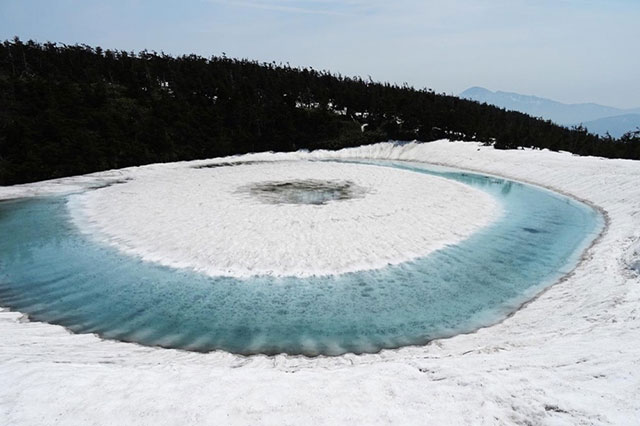
In this article we will be introducing the magnificent natural beauty of Hachimantai, an area that offers impressive scenery in all seasons as well as excellent skiing, hiking and wildlife experiences.
Whether you visit for the snowy landscapes during the winter months, the blossom in spring, the abundant alpine flowers and hiking trails during summer or the striking autumn colours in fall, you will be greeted with stunning scenery and unforgettable views upon any trip to Hachimantai!
-
Can’t decide which season is best to visit? Read on for everything you’ll need to know while planning your trip, what you can see in each season and tips on where to stay…
The Hachimantai area makes up the southern area of the Towada-Hachimantai National Park, a large park that straddles three prefectures; Aomori, Akita and Iwate.
To the north of Hachimantai is the Towada-Hakkoda part of the park which is just as beautiful, although we won’t be covering that area in this article.![Appi-Kogen Ski Resort]()
Appi-Kogen Ski Resort
We will start with the winter season. Winter in Hachimantai is very much about winter sports.
It is home to the Appi-Kogen Appi Kogen Ski Resort, the biggest in all of Tohoku and one of the best equipped in all of Japan - Appi-Kogen Appi Kogen boasts 21 different slopes, the longest of which is over 5 km in length.
Large amounts of snow fall every winter meaning it gets constant top-ups of fresh snow almost daily, the quality of which is famous for being top notch, light and exceptionally powdery.
Most of the resort, including Shimokura and Panorama, is aimed toward beginner and intermediate skiers, making it an excellent choice for big groups or families, although there are also some off-piste and side-country style tree runs for those who want to challenge themselves.
Typically the ski season runs from December through the end of March. The area also has a lot to offer for those interested in snowshoe hiking.![Hachimantai Aspite Line]()
Hachimantai Aspite Line
As the winter season winds down and the snow starts to melt, the upper reaches of Hachimantai, which are inaccessible in the thick of winter due to heavy snowfall start to open up.
In mid-April, roads that have been closed all winter are cleared leaving access routes through thick walls of solid snow on either side, which can reach up to ten meters in height! Of special note is the Hachimantai Aspite Line, which cuts straight across the park, allowing for some truly unforgettable scenes.![]()
Also, at this time of year along the Hachimantai Nature Observation Trail, various large and small lakes and ponds start to appear.
The biggest of these is Hachimantai Pond, which is very much a symbol of the area. Also, the Kagami-numa will reveal its “Dragon’s Eye” a natural phenomenon that takes place every year in May as the last of the snow recedes.![Nature Trails]()
Nature Trails
As spring kicks in proper, the landscape takes on a new lease of life as the cherry trees start to bloom. The contrast of snow peaked mountains in the background and cherry blossom in the foreground is an unusual one across most of Japan, making it fairly unique to the area. Spring also sees hiking trails open for the season, allowing visitors to start exploring different parts.
These hikes are enjoyed all through the spring and summer seasons, allowing hikers and ramblers to view a large number of alpine flora, with over 150 different types of plant and flower, as well as various animals and birds in the wild.
As peak summer season slowly encroaches the surrounding forests grow thick and luscious. Long sunny days in the forests are also pleasant and cool, making the area a popular escape from the humid cities.
The area also boasts a large number of natural hot springs, which are popular for bathing in all year round, but feel particularly nice after a long day trekking.![Autumn Colours]()
Autumn Colours
![Autumn Colours]()
Autumn Colours
As with much of Japan, as the summer winds down and the fall season kicks in, the area transforms into a wonderfully colorful landscape awash with brilliant deep reds and yellows.
Tohoku is the first part of Japan to experience the autumn colors, and is considered one of the best areas to view them, making Hachimantai as good a place as any to enjoy the season.
Being in a fairly rural part of the country, Hachimantai doesn’t have much in the way of accommodation, but it does have the very conveniently located Hachiman Mountain Hotel which sits at the foot of Appi Ski Resort and close to the hiking trail heads.![Hachimantai Mountain Hotel]()
Hachimantai Mountain Hotel
![Hachimantai Mountain Hotel]()
Hachimantai Mountain Hotel
-
![Hachimantai Mountain Hotel]()
Hachimantai Mountain Hotel
Mountain Hotel offers guests hotspring bathing, locally sourced and very delicious food options and of course comfortable common areas and lodgings.
They also have nature guides on hand in the hotel ready to help you explore the area. There are various evening activities as well provide, including star gazing.![Hachimantai Mountain Hotel]()
Hachimantai Mountain Hotel
For more information on the Hachimantai area in general and also Hachimantai Mountain Hotel you can contact them direct through their website:
Towada Hachimantai National Park Hachimantai Area:
http://www.env.go.jp/en/nature/nps/park/towada/index.html
Hachimantai Mountain Hotel:
https://hachimantai-mountainhotel.com/en
Supported by Hachimantai DMO Inc.- Towada-Hachimantai National Park
-
-
- Aomori Prefecture, Iwate Prefecture, Akita Prefecture
-
View All- 八幡平マウンテンホテル(旧八幡平リゾートホテル)
-
-
- 岩手県八幡平市松尾寄木第1地割509-1
-
-
-
- 0195784111
-
View All











 Go here
Go here





